- Home
- Glossary Term
- Automated Discounts
What are CPQ Automated Discounts?
CPQ automated discounts are smart pricing tools built into Configure, Price, Quote systems. They automatically adjust prices based on predefined business rules, customer characteristics, and deal specifics—all without requiring manual sales team intervention.
The technology eliminates guesswork from discount decisions. Instead of sales reps calculating discounts manually or waiting for management approval on routine requests, the system applies appropriate discounts instantly based on established criteria.
These systems integrate with CRM platforms and ERP systems to access real-time customer data, inventory levels, and cost information. The result is consistent, profitable pricing that accelerates quote generation while maintaining margin discipline.
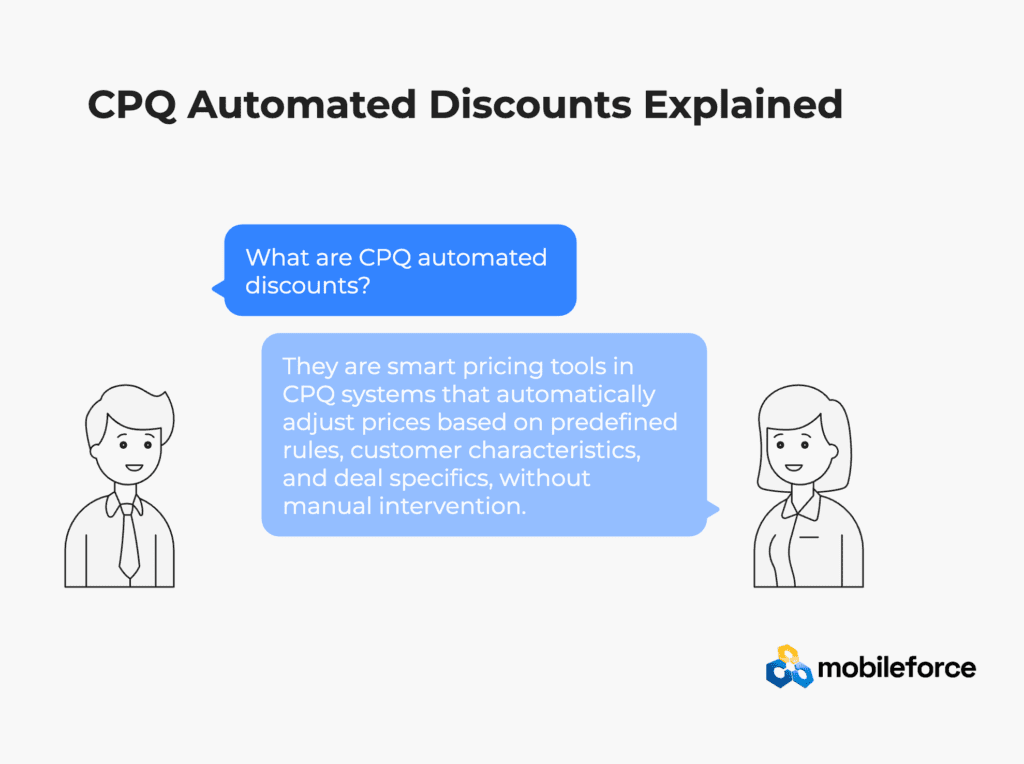

How CPQ Automated Discounts Work
The technology operates through interconnected components that share information and execute pricing decisions seamlessly.
Business Rules Engine
At the foundation sits a rules engine that processes pricing logic automatically. It evaluates multiple factors simultaneously: deal size, customer tier, product mix, competitive situations, and contract terms.
The engine works like a decision tree, but much faster. When a sales rep configures a quote, the system checks dozens of conditions in seconds and applies the appropriate discount level. No manual calculations, no waiting for approvals on standard discounts.
Smart Approval Workflows
For discounts requiring management approval, automated workflows route requests intelligently. The system knows which discounts need approval, who can approve them, and how to escalate based on discount size or customer risk.
This means routine discounts get applied immediately, while exceptional cases get proper review. Sales reps know instantly whether they can proceed or need to wait for approval.
Customer Intelligence Integration
The system pulls customer data automatically from your CRM and other sources. It knows customer tier status, purchase history, contract terms, and strategic value. This information shapes discount eligibility and pricing decisions.
Customer intelligence ensures consistent treatment of similar accounts while recognizing the unique value of strategic relationships.
Real-Time Margin Protection
Every discount calculation includes immediate margin analysis. The system knows product costs, overhead allocation, and minimum margin requirements. It won’t suggest discounts that push deals below acceptable profitability levels.
This protection happens automatically, giving sales teams confidence that their pricing decisions support business objectives.
Types of Automated Discounts
Different discount types address various sales situations and business objectives.
Volume-Based Discounts
These reward larger orders with automatic price reductions. The system calculates volume discounts based on quantities, annual commitments, or total deal value. Sales teams don’t need to remember complex volume tiers—the system handles it automatically.
Volume discounts encourage larger deals while maintaining margin discipline. The automation ensures consistent application across all sales reps and customer interactions.
Competitive Response Discounts
When sales reps identify competitive situations, the system can automatically apply competitive discounts within predefined limits. This gives teams immediate pricing flexibility without lengthy approval processes.
The automation speeds response times in competitive situations while maintaining control over margin impact. Sales teams can compete effectively without waiting for pricing approvals.
Customer Tier Discounts
Strategic accounts, preferred partners, and loyalty program members get automatic discount recognition. The system knows customer status and applies appropriate pricing without manual intervention.
This ensures valuable customers receive consistent pricing treatment while eliminating the risk of forgetting to apply earned discounts.
Bundle and Cross-Sell Incentives
When customers configure certain product combinations, the system automatically applies bundle discounts or cross-sell incentives. This encourages solution selling while optimizing overall deal profitability.
Bundle discounts work behind the scenes, making it easy for sales teams to position complete solutions at attractive pricing.
Promotional and Seasonal Discounts
Time-based promotions activate automatically during predetermined periods. End-of-quarter pushes, seasonal campaigns, and marketing promotions get consistent application without manual tracking.
The automation ensures no opportunities get missed while maintaining promotional integrity across all sales channels.
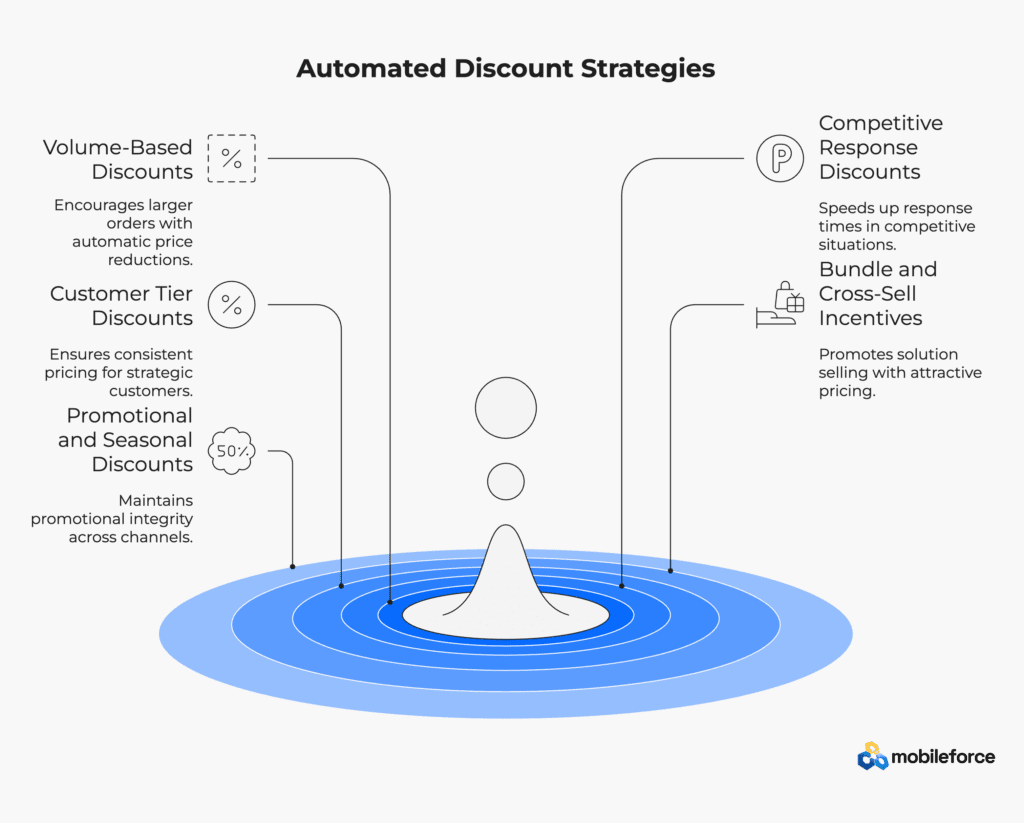
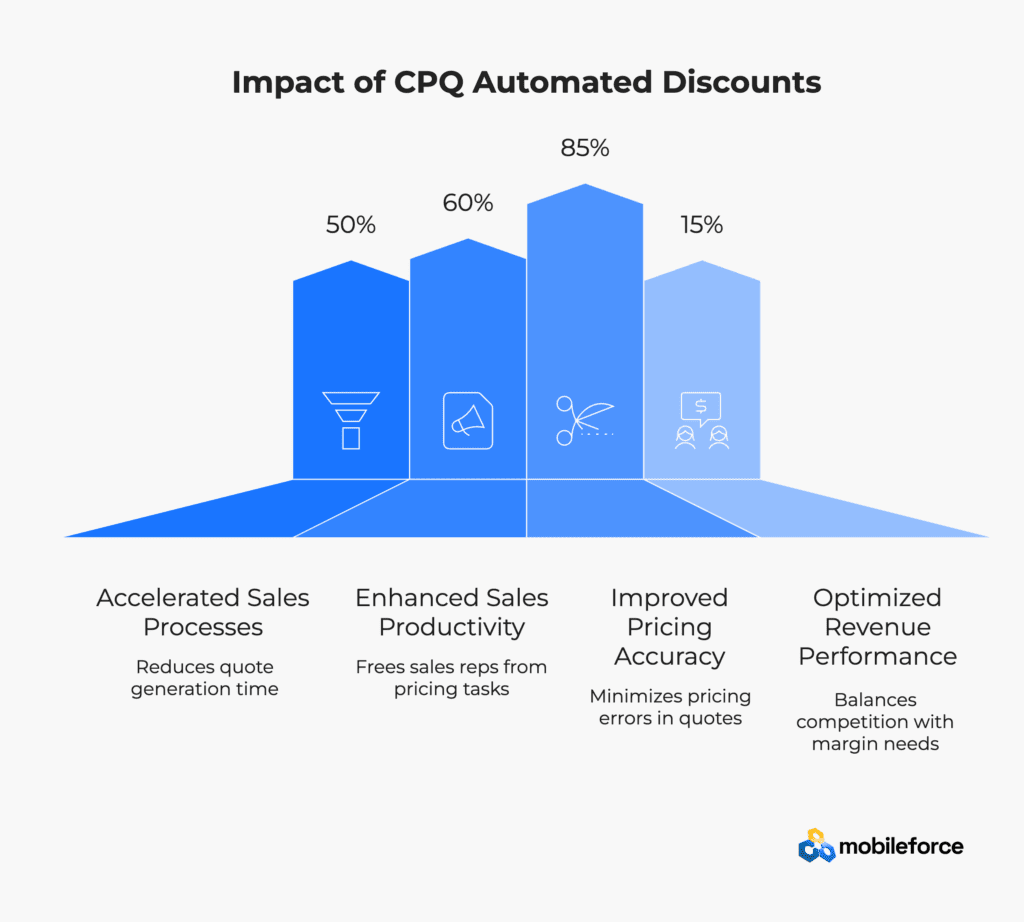
Business Impact and Results
Companies implementing CPQ automated discounts see measurable improvements across multiple areas.
Accelerated Sales Processes
Most organizations experience 40-60% reduction in quote generation time and 25-35% improvement in sales cycle velocity. Automated discount application eliminates calculation delays while ensuring consistent pricing across all customer interactions.
The speed improvements come from removing manual steps, not from cutting corners. Sales teams deliver professional quotes faster because the system handles routine pricing decisions automatically.
Enhanced Sales Productivity
Sales representatives spend 50-70% less time on pricing calculations and approval requests. This frees them to focus on customer relationships, solution positioning, and deal advancement.
The productivity gains compound over time. Sales teams can handle more opportunities while providing better customer service through faster, more accurate pricing.
Improved Pricing Accuracy
Automated systems reduce pricing errors by 80-90% compared to manual calculations. Business rules ensure consistent application of company pricing policies across all quotes and sales situations.
Better accuracy means fewer quote revisions, less confusion, and faster customer decision-making. Professional pricing builds customer confidence in both the solution and the selling organization.
Optimized Revenue Performance
Companies typically see 10-20% improvement in overall deal profitability as systems balance competitive positioning with margin requirements. The automation prevents both excessive discounting and missed opportunities.
Revenue optimization happens through better pricing decisions, not through restricting sales flexibility. Teams get the tools they need to compete while protecting company profitability.
Implementation Strategies and Best Practices
Successful implementations follow proven approaches that minimize disruption while maximizing benefits.
Phased Implementation Approach
Start with standard volume discounts and customer tier pricing before moving to complex competitive and promotional discounts. This allows teams to gain experience with automated systems while delivering immediate value.
Phased approaches also enable continuous learning and process refinement. Organizations can optimize simple discount types before tackling more complex pricing scenarios.
Comprehensive Training Programs
Sales teams need education on automated discount capabilities, approval processes, and best practices for leveraging pricing automation. Training ensures successful adoption while maximizing productivity benefits.
Effective training covers both system functionality and strategic pricing concepts. Sales reps learn not just how to use the tools, but how automated discounts support their selling success.
Process Integration and Workflow Design
Automated discount workflows must align with established sales methodologies, CRM processes, and customer engagement practices. Integration maintains familiar sales processes while enhancing them with intelligent pricing automation.
The goal is seamless enhancement, not wholesale process replacement. Sales teams should feel that automation makes their existing processes better, not different.
Performance Monitoring and Optimization
Continuous tracking of discount effectiveness, sales productivity improvements, and margin impacts enables data-driven strategy refinement. Monitoring identifies what works and what needs adjustment.
Regular optimization ensures automated discount strategies evolve with market conditions, competitive dynamics, and business objectives.

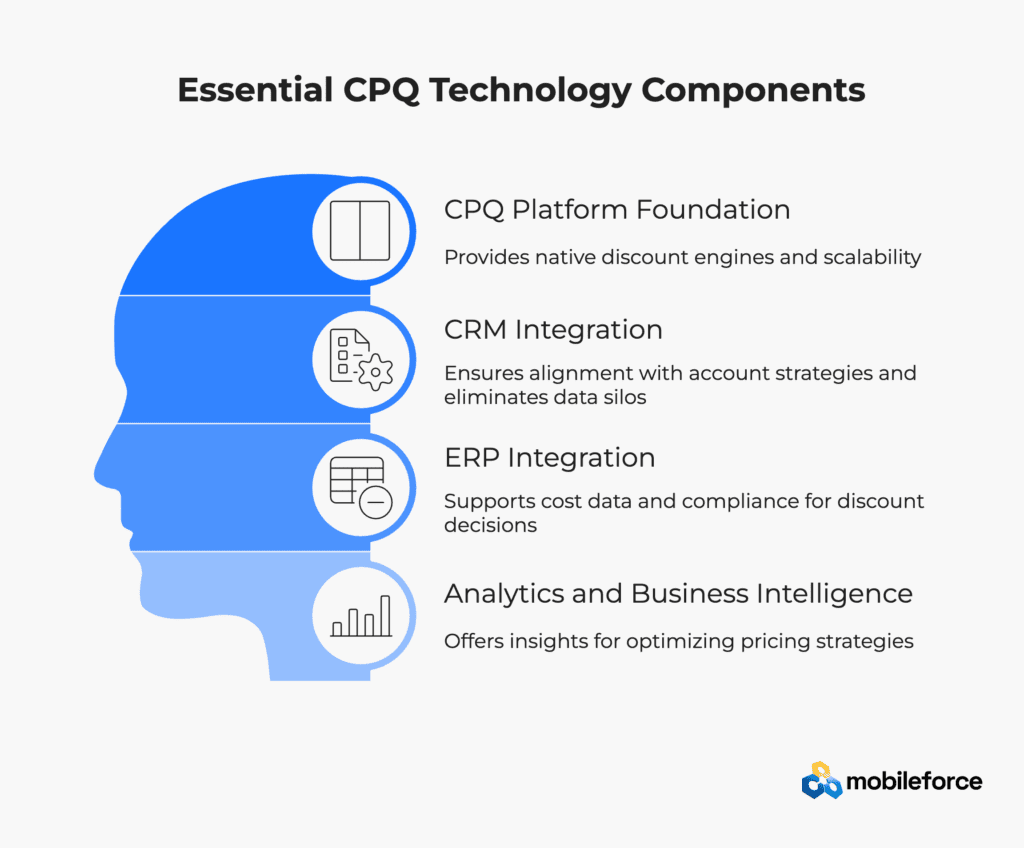
Technology Requirements and Integration
CPQ Platform Foundation
Modern CPQ platforms provide native discount engines integrated with configuration and pricing capabilities. The platform orchestrates product configuration, pricing calculations, discount application, and quote generation automatically.
Platform selection should consider both current discount needs and future automation goals. Scalable platforms grow with business requirements without requiring major system changes.
CRM and Customer Data Integration
Real-time connectivity with sales management systems provides customer information, opportunity details, and account intelligence for discount decisions. CRM integration ensures discount strategies align with account strategies and relationship objectives.
Strong integration eliminates data silos and ensures consistent customer treatment across all sales interactions and pricing decisions.
ERP and Financial System Connections
Seamless connection with financial and inventory systems provides cost data, margin calculations, and product availability information for informed discount decisions. ERP integration ensures discount calculations reflect accurate cost structures and inventory constraints.
Financial integration also supports compliance requirements and audit trails for pricing decisions and discount approvals.
Analytics and Business Intelligence
Advanced reporting and visualization tools analyze discount performance, margin impacts, and sales effectiveness to optimize pricing strategies. Analytics platforms identify trends and opportunities for continuous improvement.
Good analytics turn pricing data into actionable insights that guide both strategic decisions and tactical improvements.
Key Performance Metrics
Quote-to-Close Conversion Rates
Automated discount strategies should improve deal closure rates across different customer segments and product categories. Conversion tracking demonstrates discount effectiveness in driving revenue outcomes.
Track conversion rates by discount type, customer segment, and sales situation to identify which automated discounts deliver the best results.
Deal Size and Profitability Impact
Monitor how automated discounts influence deal values and margins to ensure strategies achieve the desired balance between competitiveness and profitability. Deal size metrics validate discount effectiveness in encouraging larger commitments.
The goal is profitable growth, not just increased deal volume. Metrics should reflect both revenue and margin performance.
Sales Cycle and Process Efficiency
Track quote generation speed, approval cycle times, and overall sales velocity improvements resulting from automated discount implementation. Efficiency metrics demonstrate operational benefits and productivity gains.
Process improvements should be measurable and significant. Small gains suggest implementation problems or inadequate automation scope.
Pricing Consistency and Compliance
Monitor discount application consistency, approval process adherence, and pricing policy compliance across sales teams and regions. Compliance metrics ensure pricing integrity while identifying training or process improvement needs.
Consistency builds customer trust and internal confidence in pricing decisions. Significant variation suggests system or training issues.
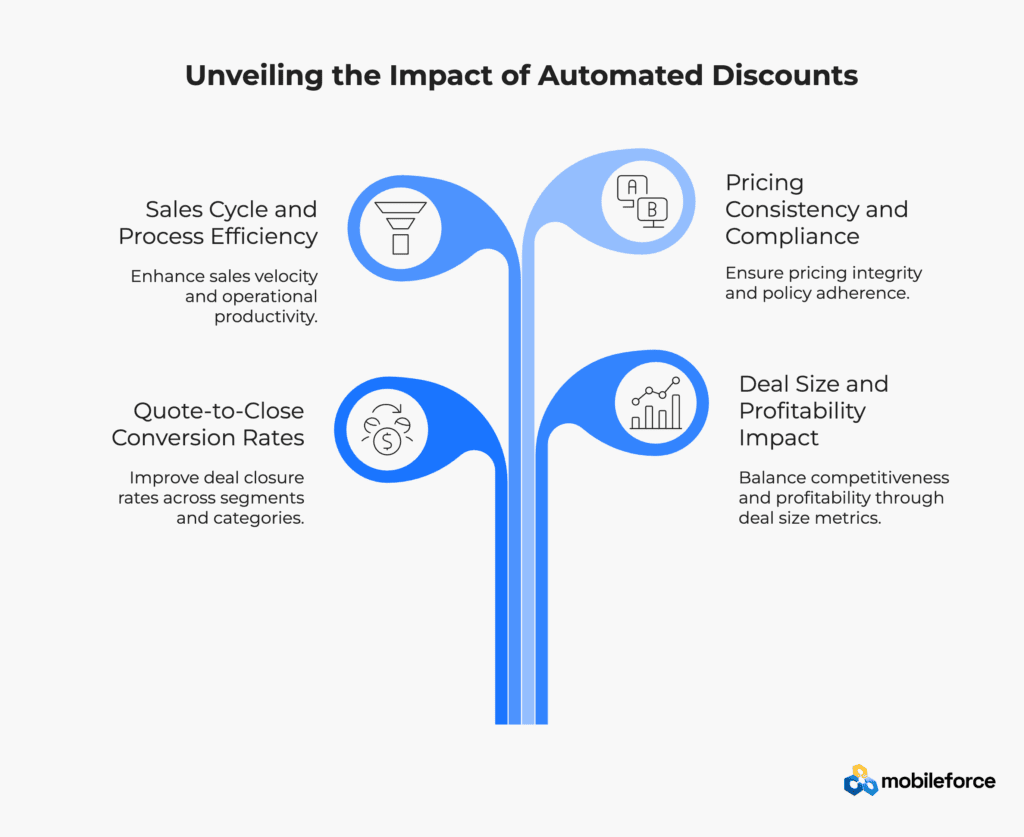

Advanced Features and Future Capabilities
AI-Powered Discount Optimization
Machine learning algorithms analyze historical deal data, customer behavior, and market conditions to recommend optimal discount strategies for specific sales situations. AI capabilities enable predictive discount modeling and intelligent strategy refinement.
AI features are evolving rapidly, but they require substantial data and careful implementation to deliver meaningful benefits over rule-based systems.
Real-Time Competitive Intelligence
Automated systems can incorporate competitive pricing data and market intelligence into discount calculations and recommendations. Competitive intelligence ensures discount strategies maintain market positioning while optimizing profitability.
Competitive intelligence works best when combined with human judgment about strategic responses and market positioning.
Dynamic Cost-Based Pricing
Sophisticated algorithms adjust discount levels based on real-time cost data, inventory levels, and margin targets. Dynamic pricing enables responsive strategies that adapt to changing business conditions.
Dynamic pricing requires robust data integration and careful business rule design to avoid pricing volatility that confuses customers or sales teams.
Common Implementation Challenges
Data Quality and Integration Issues
Automated discount systems require clean, comprehensive data across customer records, product catalogs, and cost structures. Poor data quality undermines system effectiveness and user confidence.
Address data issues before system implementation, not after. Clean data is essential for accurate discount calculations and reliable system performance.
Change Management and User Adoption
Sales teams accustomed to manual pricing control may resist automated systems. Successful implementations require comprehensive change management that addresses both practical concerns and cultural resistance.
User adoption succeeds when sales teams see automation as empowerment, not restriction. Training and communication should emphasize benefits to individual sales success.
Complexity and Scope Management
Organizations often try to automate too many discount types too quickly, creating complex systems that are difficult to manage and optimize. Phased implementations work better than comprehensive rollouts.
Start with simple, high-volume discount types before tackling complex, exception-heavy scenarios. Build confidence and expertise gradually.
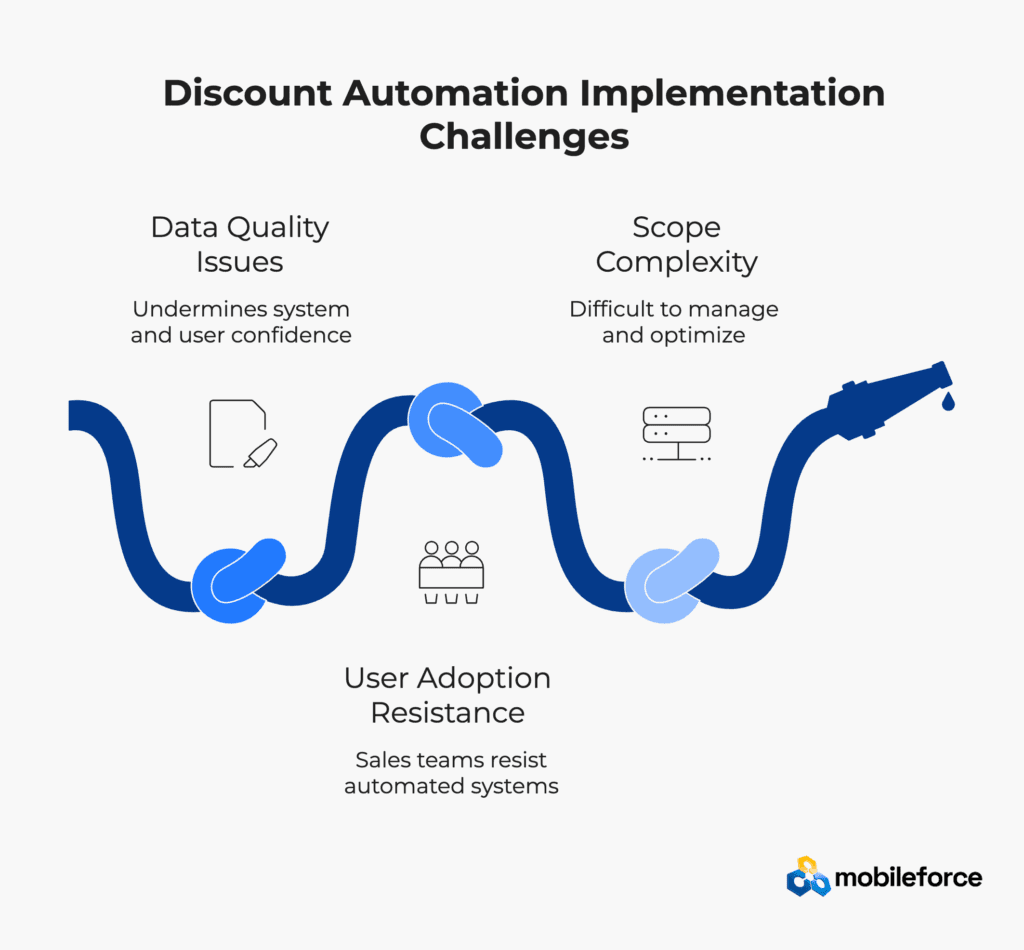
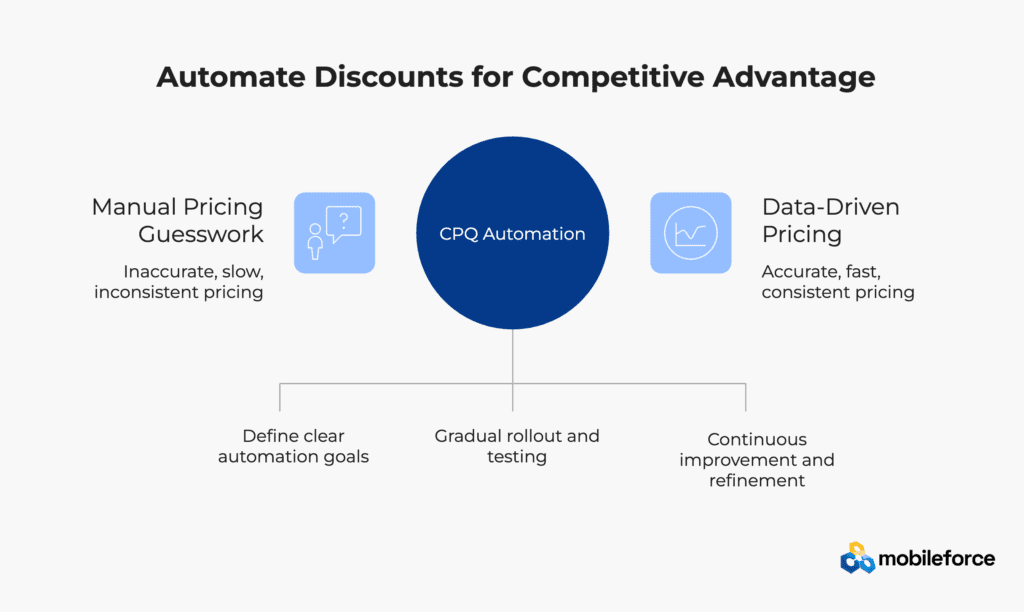
Conclusion
CPQ automated discounts transform pricing from manual guesswork to intelligent, data-driven decisions. Organizations typically see significant improvements in sales productivity, pricing accuracy, and deal profitability.
Success requires careful planning, phased implementation, and ongoing optimization. Companies that approach automation strategically create sustainable competitive advantages through faster, more consistent pricing.
The technology continues evolving rapidly, but the fundamental benefits—speed, accuracy, and consistency—remain constant. Organizations that implement automated discounts effectively position themselves for continued success in increasingly competitive markets.